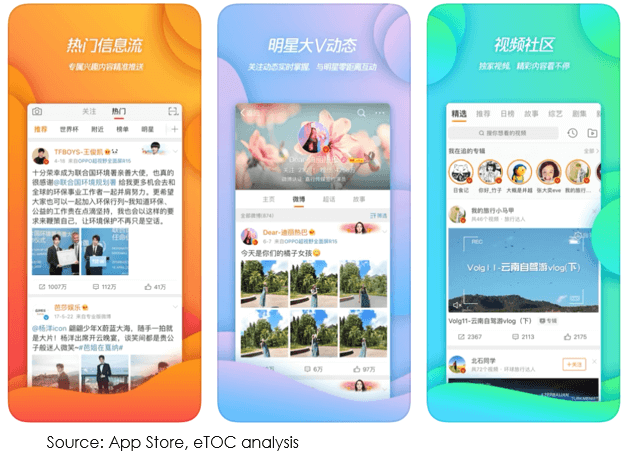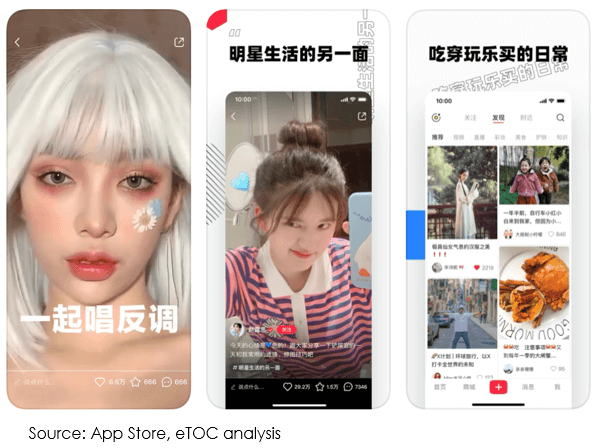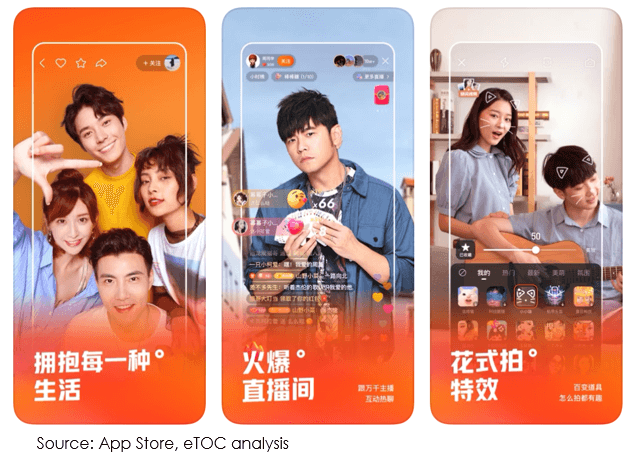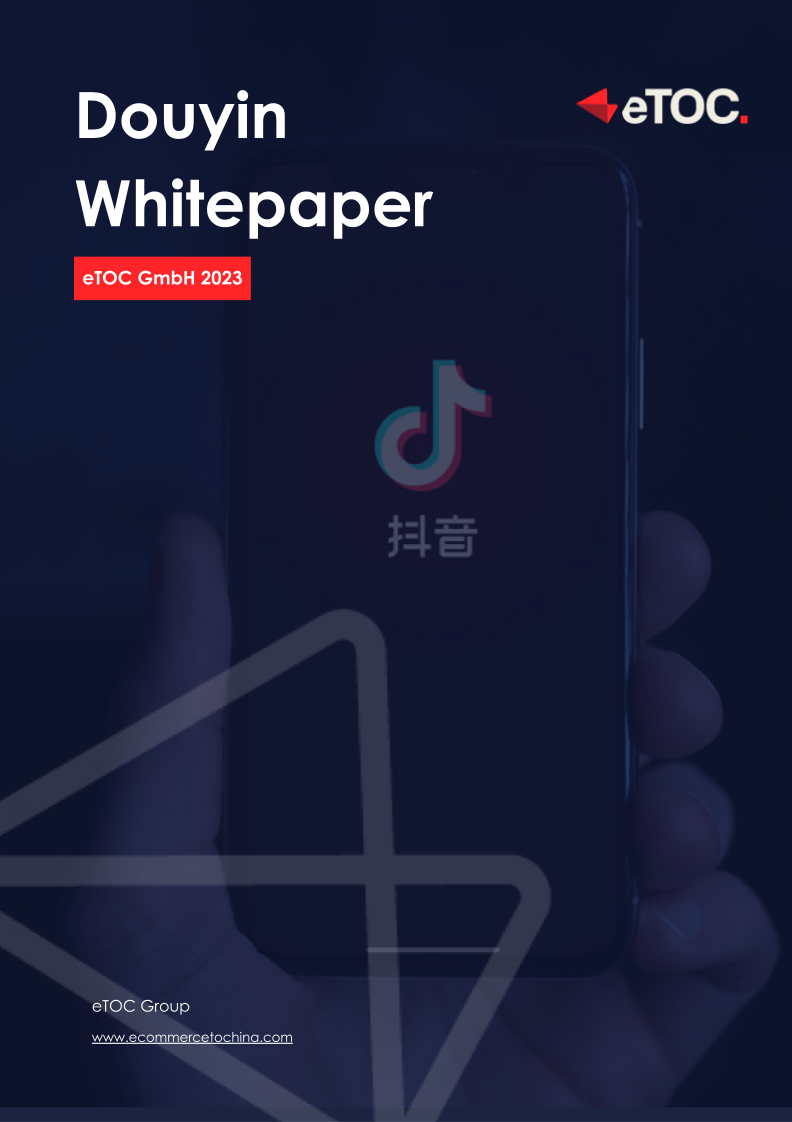
Top Chinese Social Media Platforms
In this article you will get familiar with the top chinese social media platforms: WeChat, Little Red Book, Weibo, Douyin (TikTok) and Kuaishou.
1. WeChat 微信
Originally, WeChat was developed as a simple messaging app. But why we list it in our article about the most popular social media platforms? It’s simple – WeChat developed over the years to become the absolute super app of China. There is almost no situation in life where WeChat could not be useful to its users in China. You could describe WeChat as a combination of Facebook, WhatsApp, Uber, Tinder and many more. Chatting, posting articles, ordering food, calling cabs, booking tickets, paying – WeChat enables all this and much more in just one app.
More than 1.2 billion users are active on WeChat every month. On average, each user opens the app 10.6 times a day and 34% of users are on WeChat for far more than 4 hours a day.
WeChat’s mini-programs reached a transaction volume of RMB 800 billion. These mini-programs are “sub-applications,” effectively apps within the app. They allow service providers to strengthen ties with their customers through advanced features such as their own e-commerce store.
Thus, WeChat is not only interesting for private use, but also for business accounts.
(Want to learn more about WeChat? Then also check out this article: How to sell to China via WeChat).

2. Weibo 微博
Every month, around 523 million active users use the microblogging platform Weibo. You can consider Weibo as a combination of Facebook and Twitter. Weibo allows its users to post text messages up to 140 characters long, audio, video files or photos. You can even play games on Weibo. Moreover it is the most popular platform for KOL marketing. That’s because it is straightforward, inexpensive, efficient, and essential to a company’s image building.
The mechanism of a KOL promotion is to pay them for postings or to gift them your own products. This is negotiable depending on the reach of the KOL. In return, they promote the desired products on Weibo.
What makes KOL marketing on Weibo particularly efficient is its linkage to Taobao and Tmall. Users can click on a product link or coupon displayed in a KOL post and then be redirected directly to Taobao or Tmall.

3. Little Red Book 小红书
With 200 million users, Little Red Book (RED) is the most popular content sharing platform in China. You can consider it’s features as a combination of Pinterest and Amazon. Users are encouraged to post their own photos and tag clothes, accessories or other products used accordingly.
The majority of users are young women from Chinese Tier 1 and 2 cities. Together, they create a great collaborative atmosphere by sharing whatever interests them. Thus, RED’s success is based on a strong advertising effect through word-of-mouth and the majority of consumption is generated through user-generated content (UGC). The number of monthly active users (MAU) already exceeded the 100 million mark in October 2019. The high number of users also reflects the increasing added value that the platform offers its users through sharing opportunities of consumption and lifestyles.
When the platform was founded in 2013, it was not yet a traditional e-commerce platform, but with its growing reach and resulting social influence, RED expanded its business model in 2017 and integrated e-commerce features. Nowadays, brands can set up brand accounts and customize them to suit their own style. After completing the authentication process, brands can start posting commercial posts and launching KOL campaigns. Through content operations, companies can better connect and engage with their consumers, and thus build brand loyalty. Additionally, brands have the ability to open stores on RED and even offer cross-border e-commerce. For any brand that decides to create a brand account or store on Little Red Book, content seeding is considered an absolute must-have marketing activity.
In the meantime, RED has established itself as an indispensable part of cross-border e-commerce.

4. Douyin 抖音 (TikTok)
Known as TikTok in western countries, the short video portal Douyin is particularly popular among a younger community. About 82% of the 600 million daily users are under 35. On average, they spend 52 minutes a day actively browsing the app. Douyin allows its users to upload short videos. These videos can be backed with songs and edited with various effects as desired. Once a video has been uploaded, Douyin’s algorithm ensures that it is sent to other interested users and becomes visible on its so-called “For You – Page”.
Users preferably upload dance or lip sinc videos to Douyin. This often results in trends that go viral on Douyin and are imitated countless times by other users, who post slightly different and individualized versions. Although dance and lip sinc videos still dominate on Douyin, the popularity of “story time” or everyday report videos is increasing.
Short video is becoming an increasingly important content for brands and Douyin’s huge traffic is used for their precision marketing. Douyin owns a closed loop of e-commerce marketing formed by innovative challenge gameplay, platform diversion marketing and KOL live streaming.

5. Kuaishou 快手
With 262 million daily users, and an average usage time of 86 minutes, Kuaishou is the direct rival in the short-video business of TikTok (Douyin). Kuaishou and Douyin are very similar. But unlike TikTok, users on Kuaishou share less dance or Lip-sinc videos. They focus more on their personal everyday stories. For live streaming, Kuaishou is therefore the more suitable and popular platform so far. It cooperates with e-commerce providers such as Taobao, Pinduoduo or JD.com. As a result, users can also buy products from these websites directly via Kuaishou. This cooperation optimizes the shopping experience for live streaming viewers. Viewers no longer need to search for the advertised products on other e-commerce platforms. They can easily buy them right through Kuaishou.

Are you interested in learning more about the top Chinese social media platforms and KOL marketing? Download our free whitepaper “China Digital Marketing Full Guide” or contact us directly. We are happy to help!
Download our Douyin Whitepaper

Free Download

Discover the Future of Shopping with "Shopatainment – The Future of Shopping"
Our new book “Shopatainment – The Future of Shopping” explores how the innovative fusion of shopping and entertainment is revolutionizing the way we shop. Learn about the origins of this trend in China, the technologies and formats being used, and the opportunities and challenges it presents for the West.

Want to have a first free consultation session about selling and growing in China via e-commerce and digital marketing? Contact us.
